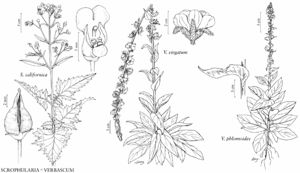Difference between revisions of "Verbascum phlomoides"
Sp. Pl. 2: 1194. 1753.
FNA>Volume Importer |
imported>Volume Importer |
||
| (5 intermediate revisions by 2 users not shown) | |||
| Line 16: | Line 16: | ||
}}{{Treatment/ID/Special_status | }}{{Treatment/ID/Special_status | ||
|code=F | |code=F | ||
| − | |label= | + | |label=Illustrated |
}} | }} | ||
|basionyms= | |basionyms= | ||
| Line 34: | Line 34: | ||
|elevation=0–600 m. | |elevation=0–600 m. | ||
|distribution=Alta.;B.C.;Man.;Ont.;P.E.I.;Que.;Sask.;Ark.;Colo.;Conn.;Del.;D.C.;Ga.;Ill.;Ind.;Iowa;Ky.;Maine;Md.;Mass.;Mich.;Minn.;Mo.;N.J.;N.Y.;N.C.;Ohio;Oreg.;Pa.;R.I.;S.C.;Tenn.;Vt.;Va.;Wash.;W.Va.;Wis.;Europe;Asia;introduced also in South America (Ecuador);Pacific Islands (New Zealand). | |distribution=Alta.;B.C.;Man.;Ont.;P.E.I.;Que.;Sask.;Ark.;Colo.;Conn.;Del.;D.C.;Ga.;Ill.;Ind.;Iowa;Ky.;Maine;Md.;Mass.;Mich.;Minn.;Mo.;N.J.;N.Y.;N.C.;Ohio;Oreg.;Pa.;R.I.;S.C.;Tenn.;Vt.;Va.;Wash.;W.Va.;Wis.;Europe;Asia;introduced also in South America (Ecuador);Pacific Islands (New Zealand). | ||
| + | |introduced=true | ||
|discussion=<p>In the flora area, <i>Verbascum phlomoides</i> is known from a single location each in Manitoba (near Roseisle) and Saskatchewan (near Moose Jaw). The record for Washington possibly is only a waif (King County, Seattle, in waste ground, introduced from Europe, 12 September 1936, W. J. Eyerdam s.n., SMU), because it apparently has not been recorded there since.</p><!-- | |discussion=<p>In the flora area, <i>Verbascum phlomoides</i> is known from a single location each in Manitoba (near Roseisle) and Saskatchewan (near Moose Jaw). The record for Washington possibly is only a waif (King County, Seattle, in waste ground, introduced from Europe, 12 September 1936, W. J. Eyerdam s.n., SMU), because it apparently has not been recorded there since.</p><!-- | ||
--><p><i>Verbascum</i> ×kerneri Fritsch is a hybrid between <i>V. phlomoides</i> and <i>V. thapsus</i>.</p> | --><p><i>Verbascum</i> ×kerneri Fritsch is a hybrid between <i>V. phlomoides</i> and <i>V. thapsus</i>.</p> | ||
| Line 44: | Line 45: | ||
-->{{#Taxon: | -->{{#Taxon: | ||
name=Verbascum phlomoides | name=Verbascum phlomoides | ||
| − | |||
|authority=Linnaeus | |authority=Linnaeus | ||
|rank=species | |rank=species | ||
| Line 59: | Line 59: | ||
|publication title=Sp. Pl. | |publication title=Sp. Pl. | ||
|publication year=1753 | |publication year=1753 | ||
| − | |special status=Weedy;Introduced; | + | |special status=Weedy;Introduced;Illustrated |
| − | |source xml=https:// | + | |source xml=https://bitbucket.org/aafc-mbb/fna-data-curation/src/2e0870ddd59836b60bcf96646a41e87ea5a5943a/coarse_grained_fna_xml/V17/V17_56.xml |
|genus=Verbascum | |genus=Verbascum | ||
|species=Verbascum phlomoides | |species=Verbascum phlomoides | ||
Latest revision as of 19:32, 5 November 2020
Biennials. Stems (30–)50–200 cm, densely and persistently tomentose, eglandular. Leaves: surfaces densely and persistently tomentose, eglandular; basal and proximal cauline with petiole 40–80 mm; blade ovate-lanceolate to ovate-elliptic or oblong, (10–)15–25(–35) × 4–10(–15) cm, base attenuate; cauline subauriculate-clasping, gradually smaller distally, base not decurrent, rarely slightly so, margins entire or shallowly crenate, apex of distal cauline and floral bracts caudate-acuminate to short-acuminate. Inflorescences unbranched, narrowly cylindric, flowers densely overlapping or remote proximally, in clusters of 2–9; rachis densely and persistently tomentose, eglandular; bracts ovate-lanceolate, 9–15 mm, base short-decurrent or not at all, apex acute to short-acuminate, densely and persistently tomentose, eglandular. Pedicels adnate to rachis at base, 2–8(–15) mm; bracteoles 2. Flowers: calyx 5–12 mm, densely and persistently tomentose, eglandular, lobes lanceolate to triangular; corolla yellow, 30–55 mm diam., pellucid glands absent or relatively few; proximal filaments glabrous at least distally, distal pair villous, hairs white or yellow; stigma spatulate, base decurrent. Capsules elliptic-ovoid, 5–8 mm, tomentose. 2n = 32.
Phenology: Flowering Jun–Aug.
Habitat: Fields, roadsides, disturbed sites.
Elevation: 0–600 m.
Distribution
Introduced; Alta., B.C., Man., Ont., P.E.I., Que., Sask., Ark., Colo., Conn., Del., D.C., Ga., Ill., Ind., Iowa, Ky., Maine, Md., Mass., Mich., Minn., Mo., N.J., N.Y., N.C., Ohio, Oreg., Pa., R.I., S.C., Tenn., Vt., Va., Wash., W.Va., Wis., Europe, Asia, introduced also in South America (Ecuador), Pacific Islands (New Zealand).
Discussion
In the flora area, Verbascum phlomoides is known from a single location each in Manitoba (near Roseisle) and Saskatchewan (near Moose Jaw). The record for Washington possibly is only a waif (King County, Seattle, in waste ground, introduced from Europe, 12 September 1936, W. J. Eyerdam s.n., SMU), because it apparently has not been recorded there since.
Verbascum ×kerneri Fritsch is a hybrid between V. phlomoides and V. thapsus.
Selected References
None.
